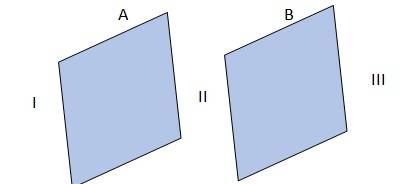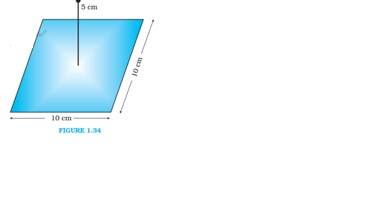Electric Charges and Fields
Get insights from 101 questions on Electric Charges and Fields, answered by students, alumni, and experts. You may also ask and answer any question you like about Electric Charges and Fields
Follow Ask QuestionQuestions
Discussions
Active Users
Followers
New answer posted
6 months agoContributor-Level 10
1.24 The given conditions are explained in the adjacent diagram

Where A and B represent two large, thin metal plates, parallel and close to each other. The outer surface of A is shown as I, outer surface of B is shown as II and the surface in between A and B is shown as III.
Charge density of plate A, = 17.0 C/
Charge density of plate B, = 17.0
C/
(a) & (b) In the region, I and III, electric field E is zero, because charge is not enclosed by the respective plates.
(c) Electric field, E in the region II is given by
E =
, where
= Permittivity of free space = 8.854
E = N/C = 1.92 N/C
New answer posted
6 months agoContributor-Level 10
1.23 Electric field produced by the infinite line charge at a distance d having linear charge density
is given by
E = , where
E = Electric field = 9 N/C
= Permittivity of free space = 8.854
d = 2 cm = 0.02 m
Hence, = 9
8.854
0.02 = 10
New answer posted
6 months agoContributor-Level 10
1.22
(a) Diameter of the sphere, d = 2.4 m, Radius, r = 1.2 m
Surface charge density, = 80 μC/
Total charge on the surface of the sphere is given by Q =
Hence Q = 80
(b) The total electric flux (
where
Q = 1.447
New answer posted
6 months agoContributor-Level 10
1.21 Electric field intensity, E, at a distance d, from the centre of a sphere containing net charge q is given by the relation,
E =
Where
q= Net charge
E = 1.5
d = 2r = 20 cm = 0.2 m
q = E
= 6.67 nC
The net charge on the sphere is 6.67 nC
New answer posted
6 months agoContributor-Level 10
1.20 Electric flux,
Radius of Gaussian surface, r = 10 cm = 0.1 m
(a) Electric flux piercing through a surface depends on the net charge enclosed inside a body, not on the size of the body. Hence, if the radius is doubled, the net flux passing does not change. The net flux passing will remain as -1 N
(b) The relation between point charge and the electric flux is given by
Where
Hence point charge q = φ
= - 8.854
New answer posted
6 months agoContributor-Level 10
1.19 Net electric flux (
where
q= 2.0 μC
New answer posted
6 months agoContributor-Level 10
1.18 The square can be considered as one face of a cube of edge 10 cm with a centre where charge q is placed.
According to Gauss's theorem for a cube, total electric flux is through all its six faces.
We have q = +10
Hence, =
New answer posted
6 months agoContributor-Level 10
1.17 (a) Net outward flux through the surface of the box ,
For a body containing net charge q, flux is given by the relation,
where
Hence q =
= 7.0832
(b) Net flux piercing out through a body depends on the net charge contained in the body. If net flux is zero, then it can be inferred that the net charge inside the body is zero. The body may have equal amount of positive and negative charges.
New answer posted
6 months agoContributor-Level 10
1.16 When the cube side is oriented so that its faces are parallel to the coordinate planes, number of field lines entering the cube is equal to the number of field lines piercing out of the cube. A as a result, net flux through the cube is zero.
New answer posted
6 months agoContributor-Level 10
1.15 (a) Electric field intensity, E = 3
Magnitude of electric field intensity,
N/C
Side of the square, s = 10 cm = 0.1 m
Area of the square, A =
The plane of the square is parallel to the y-z plane, hence the angle between the unit vector normal to the plane and electric field,
Flux (
(b) When the normal to its plane make a 60
. From the equation
Taking an Exam? Selecting a College?
Get authentic answers from experts, students and alumni that you won't find anywhere else
Sign Up on ShikshaOn Shiksha, get access to
- 65k Colleges
- 1.2k Exams
- 679k Reviews
- 1800k Answers

